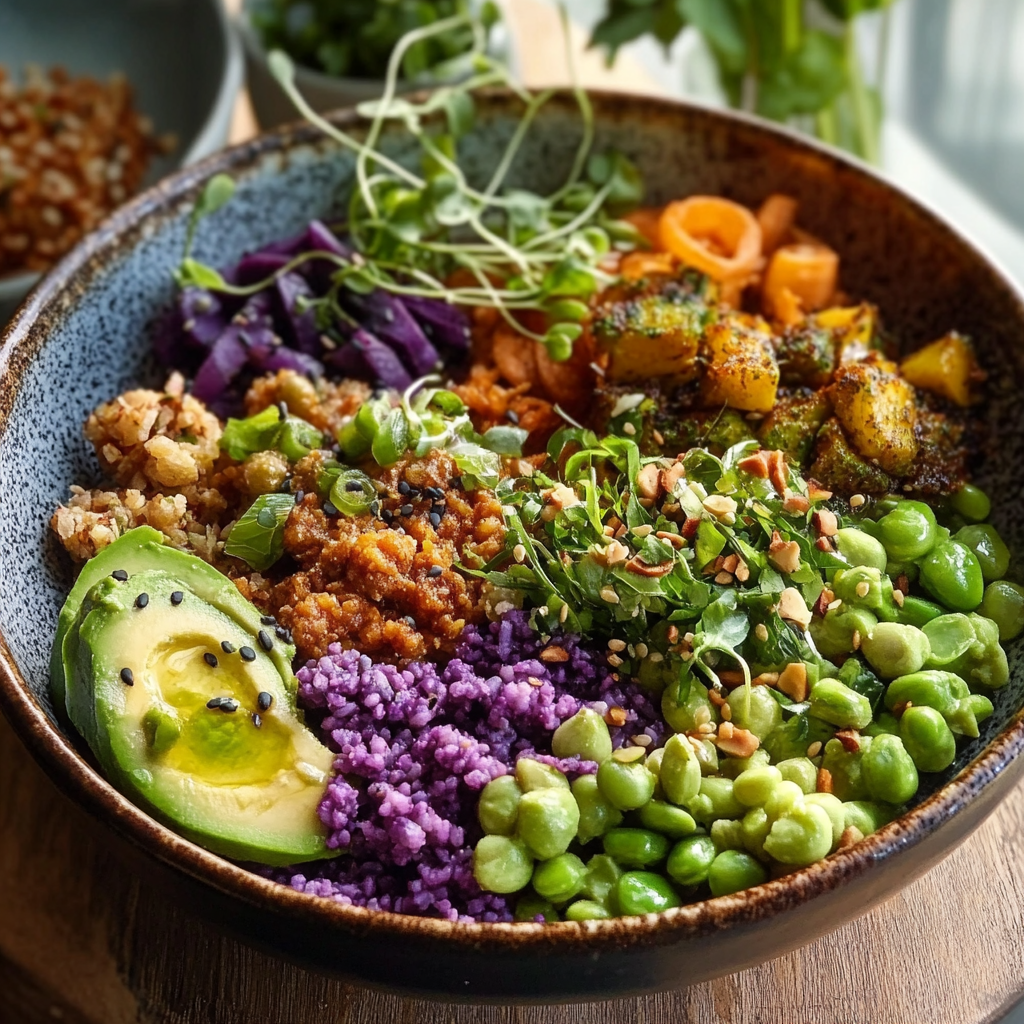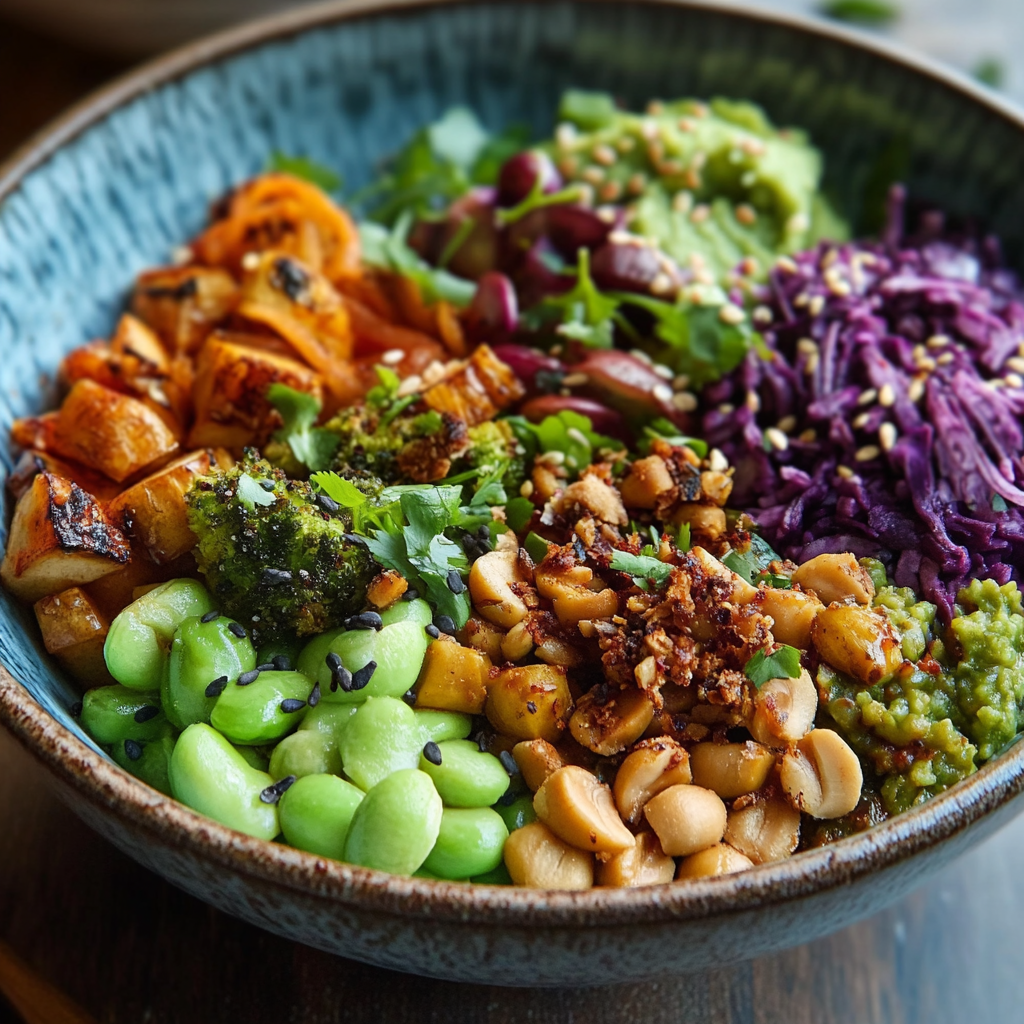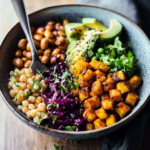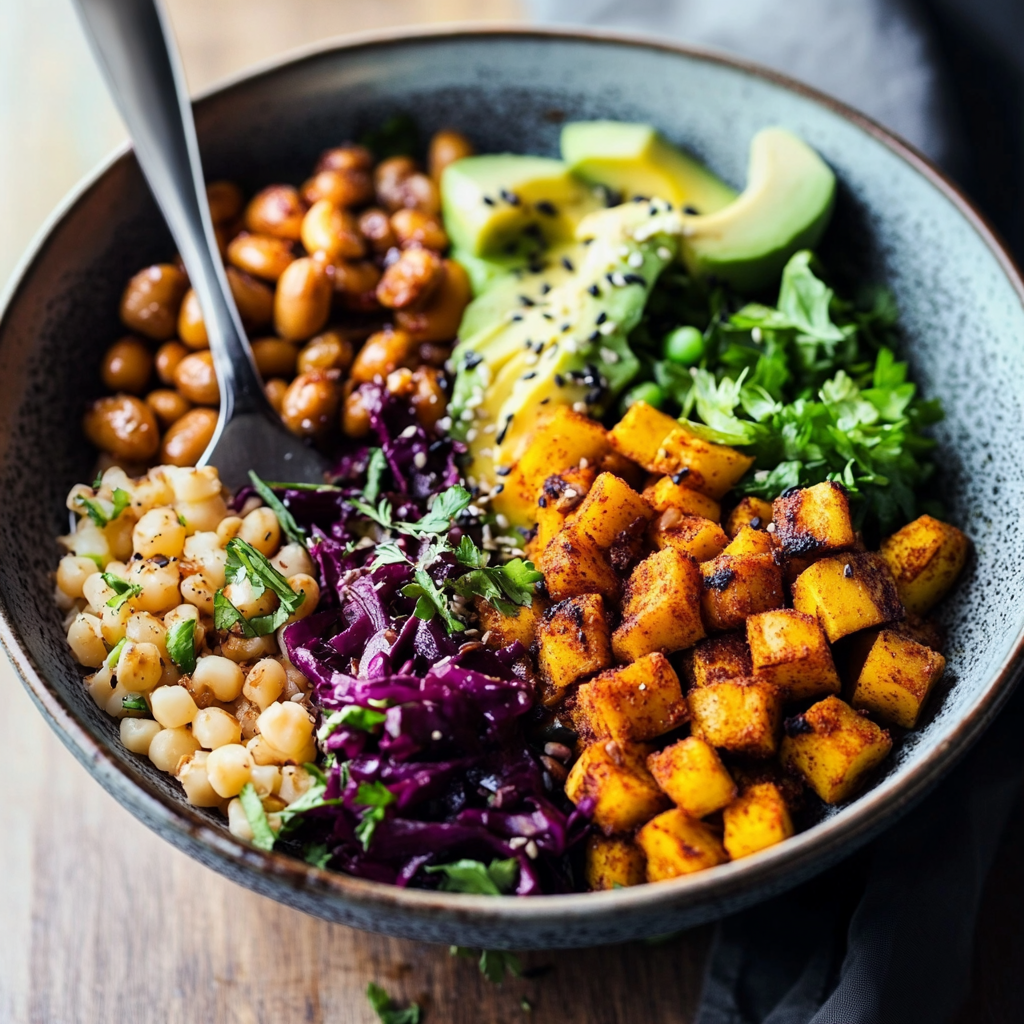Have you ever tasted a dish that feels like a celebration on your plate? Picture this: an array of colorful vegetables, hearty grains, and zesty dressings all artfully arranged in a bowl. The Vegan Buddha Bowl is not just a meal; it’s an experience that brings together diverse flavors and textures. Each bite offers a delightful crunch from fresh veggies and a satisfying chew from grains, creating harmony on your palate.
Whether you’re seeking a quick lunch or an eye-catching dinner party centerpiece, these bowls are the perfect solution. They are versatile enough to accommodate seasonal produce and can be customized to suit your personal taste preferences. Anticipate the burst of flavors that awaits you as you dive into this nourishing delight!
Why You’ll Love This Vegan Buddha Bowls
Nutrient-Packed Goodness: These bowls are loaded with vitamins, minerals, and fiber thanks to the variety of fresh vegetables and whole grains included in each serving. By choosing colorful ingredients like spinach, carrots, and sweet potatoes, you’re ensuring a nutrient-dense meal that supports your health.
Quick and Easy Meal Prep: Preparing Vegan Buddha Bowls is simple and efficient. You can batch-cook grains and roast vegetables ahead of time, making it easy to assemble your meals throughout the week. With just a few minutes of assembly time each day, you’ll have wholesome lunches or dinners ready to go.
Customizable for Everyone: One of the best features of Vegan Buddha Bowls is their versatility. You can easily swap out ingredients based on what you have on hand or cater to dietary restrictions. Whether you prefer quinoa over rice or want to add tofu instead of chickpeas, these bowls can be tailored to fit anyone’s taste.
Visual Appeal: Let’s be honest—eating with your eyes first makes everything more enjoyable! The vibrant colors found in Vegan Buddha Bowls create an inviting presentation that draws people in. It’s guaranteed to impress guests at dinner parties or spark excitement at family mealtime.
Ingredients
Here’s what you’ll need to make this delicious dish:
- Quinoa: A protein-rich grain that serves as a great base for your bowl; choose either white or red quinoa for added color.
- Kale or Spinach: Fresh greens provide vitamins A and C while adding a lovely crunch; opt for tender baby spinach for a milder flavor.
- Chickpeas: Canned or cooked chickpeas add heartiness and plant-based protein; rinse canned varieties thoroughly before use.
- Cherry Tomatoes: Sweet and juicy tomatoes offer freshness; halving them enhances their flavor profile within the bowl.
- Avocado: Creamy avocado adds richness while providing healthy fats; choose ripe avocados for optimal flavor.
For the Dressing:
- Tahini: This sesame paste creates a creamy dressing base; combine it with lemon juice for bright acidity.
The full ingredients list, including measurements, is provided in the recipe card directly below.
How to Make Vegan Buddha Bowls
Follow these simple steps to prepare this delicious dish:
Prepare the Grains: Start by rinsing one cup of quinoa under cold water. In a medium saucepan, combine it with two cups of water or vegetable broth. Bring it to a boil over medium heat. Once boiling, reduce heat to low, cover the pot, and let it simmer for about 15 minutes until all liquid has absorbed.
Roast the Vegetables: Preheat your oven to 400°F (200°C). On a baking sheet lined with parchment paper, toss diced sweet potatoes and sliced bell peppers with olive oil, salt, and pepper. Roast in the oven for approximately 25-30 minutes until tender and lightly caramelized.
Prepare the Chickpeas: If using canned chickpeas, drain and rinse them well under cold water. For added flavor, sauté them in a skillet over medium heat with olive oil, garlic powder, paprika, salt, and pepper for about five minutes until warmed through.
Assemble Your Bowl: In each serving bowl, start by layering cooked quinoa as your base. Add generous portions of kale or spinach on top followed by roasted sweet potatoes and bell peppers along with chickpeas.
Add Fresh Ingredients: Top off each bowl with halved cherry tomatoes and slices of avocado. Drizzle tahini dressing over everything generously to enhance flavors.
Transfer to plates and enjoy your beautifully arranged Vegan Buddha Bowls!

Tips and Tricks
Here are some helpful tips to ensure the best results for your dish:
Use Seasonal Vegetables: Opting for seasonal produce not only enhances flavor but also ensures freshness in your Vegan Buddha Bowls. Visit local farmers’ markets for inspiration!
Experiment with Dressings: While tahini dressing is fantastic, don’t hesitate to try different dressings like balsamic vinaigrette or peanut sauce for unique flavor profiles that complement various ingredients.
Add Crunch with Toppings: To elevate textures further in your bowls consider sprinkling nuts or seeds such as pumpkin seeds or slivered almonds on top before serving.
Make It Ahead of Time: Prepare components like grains and roasted veggies ahead of time so you can quickly assemble meals throughout busy weeks without compromising nutrition.
By following these guidelines alongside this recipe you’ll master creating deliciously balanced Vegan Buddha Bowls every time!
Mistakes to avoid
Overloading Your Bowl
One common mistake when making Vegan Buddha Bowls is overloading them with too many ingredients. While variety is important, an excessive amount can lead to a chaotic mix of flavors and textures. Aim for balance instead. Choose a few main components like grains, proteins, and vegetables, then complement them with smaller amounts of dressings or toppings. This approach not only keeps your bowl visually appealing but also allows each ingredient to shine through without overwhelming your palate.
Neglecting Flavor Profiles
Another frequent error is neglecting the importance of flavor profiles in Vegan Buddha Bowls. Each ingredient should contribute to the overall taste. Avoid bland combinations by incorporating a variety of flavors—sweet, salty, spicy, and umami. For instance, pair roasted sweet potatoes with tangy tahini dressing or spicy chickpeas with fresh herbs. Experimenting with spices and seasonings will elevate your dish and make every bite enjoyable.
Ignoring Texture
Texture plays a crucial role in creating satisfying Vegan Buddha Bowls. A common mistake is sticking only to soft ingredients, which can result in a less exciting meal. To avoid this pitfall, incorporate a range of textures by adding crunchy elements like nuts or seeds alongside creamy components such as avocado or hummus. Mixing different textures enhances the eating experience and makes your bowl more delightful.
Using Dull Dressings
Many people overlook the impact that dressings have on their Vegan Buddha Bowls. Using dull or store-bought dressings can detract from the freshness of your ingredients. Instead, consider making homemade dressings using fresh herbs, citrus juices, and flavorful oils. A zesty lemon-tahini dressing or a spicy peanut sauce can transform your bowl from ordinary to extraordinary, enhancing both flavor and enjoyment.
Skipping Meal Prep
Failing to prepare ahead of time is another mistake that can hinder the enjoyment of Vegan Buddha Bowls. When you don’t prep ingredients in advance, it may feel daunting to assemble a nutritious meal on busy days. Dedicate some time each week to wash and chop veggies or cook grains in batches. This practice not only saves time but also encourages healthier eating habits when nutritious ingredients are readily available for quick assembly.
Forgetting About Seasoning
A major oversight in crafting Vegan Buddha Bowls is forgetting about seasoning each component properly. Many assume that vegetables are inherently flavorful; however, they often require seasoning to enhance their natural taste. Always season grains while cooking and toss roasted vegetables with salt and pepper before baking them. Don’t forget to taste as you go; proper seasoning can make all the difference in achieving a harmonious flavor profile.
Not Balancing Macronutrients
Lastly, failing to balance macronutrients is a common mistake when preparing Vegan Buddha Bowls. Each bowl should ideally contain carbohydrates, proteins, and healthy fats for optimal nutrition and satiety. A well-rounded bowl might include quinoa for carbs, chickpeas for protein, and avocado for healthy fats. This balance ensures you receive all necessary nutrients while keeping you full longer throughout the day.

FAQs
What are Vegan Buddha Bowls?
Vegan Buddha Bowls are colorful meals composed of various plant-based ingredients served in a single bowl. They typically include grains like quinoa or brown rice, protein sources such as beans or tofu, numerous vegetables, and delicious dressings or sauces.
How do I create a balanced Vegan Buddha Bowl?
To create a balanced Vegan Buddha Bowl, start by selecting a base grain like quinoa or brown rice for carbohydrates. Add protein sources such as chickpeas or lentils along with various colorful vegetables for vitamins and minerals. Don’t forget healthy fats like avocado or nuts for added richness.
Can I make my Vegan Buddha Bowl ahead of time?
Absolutely! Preparing your Vegan Buddha Bowl ahead of time can save time during busy days while ensuring you eat healthily. Store individual components separately in airtight containers in the fridge for freshness so you can assemble your bowl quickly when needed.
What types of dressings work best with Vegan Buddha Bowls?
The best dressings for Vegan Buddha Bowls are those that enhance flavors without overwhelming them. Consider tangy lemon-tahini sauce or spicy peanut dressing as they complement various ingredients beautifully while adding zest to your meal.
Are there any tips for meal prepping Vegan Buddha Bowls?
When meal prepping Vegan Buddha Bowls, focus on batch cooking grains and proteins while washing and chopping vegetables ahead of time. Store everything separately in airtight containers so you can easily mix and match components each day for variety throughout the week.
Serving Suggestions
This Vegan Buddha Bowls dish is versatile and pairs wonderfully with a variety of sides and toppings. You can serve it with a fresh cucumber salad to add a refreshing crunch. Thinly sliced cucumbers tossed in rice vinegar, sesame oil, and sesame seeds create a delightful contrast to the hearty ingredients of the bowl.
For a heartier option, consider adding roasted chickpeas seasoned with paprika and garlic powder. These provide a satisfying crunch and an extra protein boost. Roasting at 400°F for about 20 minutes will give them a crispy texture that elevates your Buddha bowl experience.
You can also serve Vegan Buddha Bowls with a side of quinoa or brown rice for added fiber and nutrients. Cooking quinoa in vegetable broth enhances its flavor, making it an ideal base for your bowl. Aim for a 1: 2 ratio of quinoa to broth, simmering until fluffy.
Top off your Vegan Buddha Bowls with avocado slices for creaminess. Avocados are rich in healthy fats, making them an excellent addition. Just slice them just before serving to maintain their vibrant color.

FAQs
What ingredients are essential for Vegan Buddha Bowls?
For a delicious Vegan Buddha Bowl, you need a base like quinoa or brown rice, various vegetables such as bell peppers and kale, protein sources like beans or tofu, and toppings like avocado and nuts. The key is balancing flavors and textures while ensuring vibrant colors.
Can I customize my Vegan Buddha Bowls?
Absolutely! One of the best aspects of Vegan Buddha Bowls is their adaptability. You can swap out vegetables based on seasonality or personal preference. Try using sweet potatoes instead of regular potatoes or mix different grains like farro or barley for variety.
How do I store leftover Vegan Buddha Bowls?
Store leftover Vegan Buddha Bowls in airtight containers in the refrigerator. Keep the dressing separate to avoid sogginess. Most components will stay fresh for up to three days; however, consume them sooner for optimal taste and texture.
Are Vegan Buddha Bowls gluten-free?
Yes, all ingredients in Vegan Buddha Bowls can be gluten-free if you choose gluten-free grains like quinoa or rice. Always check labels on packaged ingredients like sauces to ensure they are free from gluten-containing additives.
Conclusion
Vegan Buddha Bowls offer a delightful combination of flavors, textures, and nutrients that cater to various dietary needs. By selecting fresh vegetables, wholesome grains, and protein-rich toppings, you can create a nutritious meal that’s both satisfying and visually appealing. Remember that customization is key; feel free to swap ingredients based on seasonal availability or personal taste preferences. Pairing your bowl with complementary sides boosts both flavor and nutrition while enhancing the overall dining experience. Enjoy experimenting with different combinations to find your perfect blend of ingredients!

Vegan Buddha Bowls
- Total Time: 45 minutes
- Yield: Serves 4
Description
Transform your meal experience with vibrant Vegan Buddha Bowls, a delightful blend of fresh, colorful vegetables, hearty grains, and creamy dressings. This nutritious dish is not only visually appealing but also packed with essential nutrients to fuel your body. Ideal for lunch or dinner, these customizable bowls allow you to mix and match seasonal ingredients according to your taste preferences. With a simple preparation process and endless variations, Vegan Buddha Bowls make healthy eating exciting and satisfying. Dive in and discover the perfect harmony of flavors and textures in every bite!
Ingredients
- 1 cup quinoa
- 2 cups water or vegetable broth
- 2 cups kale or spinach
- 1 can (15 oz) chickpeas
- 1 cup diced sweet potatoes
- 1 cup chopped bell peppers
- 1 cup halved cherry tomatoes
- 1 ripe avocado
- 3 tablespoons tahini
- Juice of 1 lemon
- Olive oil, salt, and pepper to taste
Instructions
- Rinse quinoa under cold water. In a saucepan, combine quinoa and water or broth. Bring to a boil, then reduce heat and simmer for about 15 minutes until liquid is absorbed.
- Preheat oven to 400°F (200°C). Toss sweet potatoes and bell peppers with olive oil, salt, and pepper on a baking sheet. Roast for 25-30 minutes until tender.
- Drain and rinse chickpeas. Sauté in a skillet with olive oil, garlic powder, paprika, salt, and pepper for about five minutes until warmed.
- Assemble bowls: layer cooked quinoa as the base, add greens, roasted veggies, chickpeas, halved tomatoes, and slices of avocado.
- Drizzle tahini dressing (mix tahini and lemon juice) over the top before serving.
- Prep Time: 15 minutes
- Cook Time: 30 minutes
- Category: Main
- Method: Baking
- Cuisine: Vegan
Nutrition
- Serving Size: 1 bowl (approx. 400g)
- Calories: 450
- Sugar: 6g
- Sodium: 250mg
- Fat: 17g
- Saturated Fat: 2g
- Unsaturated Fat: 14g
- Trans Fat: 0g
- Carbohydrates: 63g
- Fiber: 15g
- Protein: 14g
- Cholesterol: 0mg

